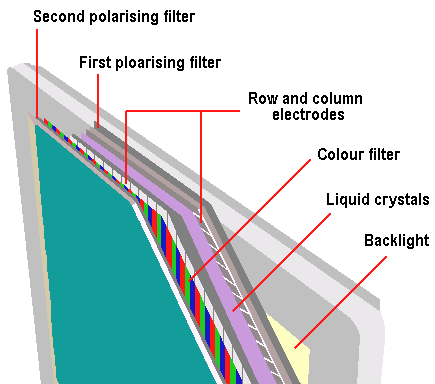In the portable arena the dramatic weight, size and power consumption benefits of LCD technology has, for several years, outweighed their relative high cost. By the late 1990s notebook screen sizes had topped out at around 15in and two designs had achieved a position of dominance over earlier, less efficient techniques:
- dual scan (DSTN), and
- thin film transistor (TFT).
The former – which controls the LCD elements via passive matrix addressing – consumes less power and is considerably less expensive than its rival technology. TFT’s active matrix design, however, is capable of significantly superior display performance.
The two designs share the same basic principles of operation and construction, both working by the polarisation of light. LCDs are a transmissive display technology, relying on a backlight to produce light which is then selectively blocked by other components. This is generally a set of low-voltage fluorescent tubes, arranged so that they spread light across the display as evenly as possible, usually with the aid of a diffusing filter. These produce pure white light and run at several kHz to eliminate flicker. This light passes through a sandwich of glass, liquid crystals and polarising filters. Liquid crystals twist when a voltage is applied to them, and this twisting changes the polarisation of the light passing through. The first polarising filter ensures that light going into the liquid crystal is polarised in one direction only. Row and column electrodes allow the display’s electronics to turn any pixel fully on, fully off, or be set to any value in between. The liquid crystals alter the polarisation of the light in proportion to the voltage applied to liquid crystal mixture. With a red, green and blue element for each pixel, a colour filter is able to produce the appropriate colour of the spectrum for each displayed pixel. Depending on the amount of twist applied by the liquid crystal, the second polarising filter blocks some or none of the light passing through.

DSTN and TFT LCDs – together with a number of other emerging display technologies – are covered in detail in the flat panel display guide.
- Flat panel displays for mobile computers – laptops, notebooks and netbooks
- Battery technology for mobile computers – laptops, notebooks and webbooks
- Laptop, notebook and netbook expansion devices
- Expansion interfaces for laptops, notebooks and other mobile computers
- DynaSheet
- External keyboards for mobile computers.
- USB On-The-Go – USB technology for PDAs and mobile phones
- Guide to Kensington Slot (K-lock, Kensington Lock, Universal Security Lock) mobile device security